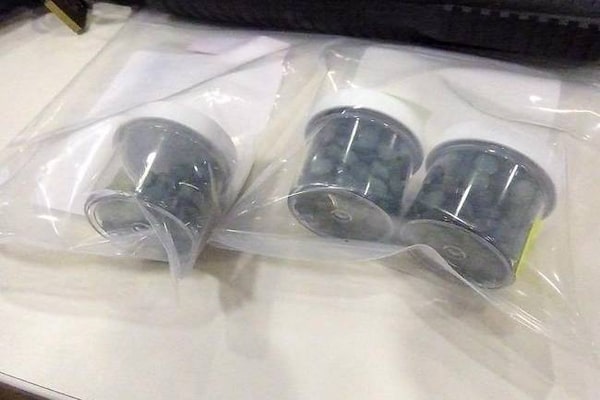
Fentanyl pills are seen in this undated handout photo.
In the fall of 2014, a U.S. special agent posed as a drug buyer in contact with a trafficker, wiring $2,700 in U.S. dollars to the alleged dealer and received a Canada Post envelope with 396 pills containing a fentanyl analogue.
The trafficker's e-mail account was eventually traced to an inmate at Quebec's medium-security federal jail, a man who had come to Canada as a child from Colombia. He was charged along with a fellow inmate at the Drummond penitentiary as part of a sweeping investigation by U.S. authorities into an alleged international opioids-trafficking operation.
U.S. officials announced on Tuesday that four other people from Canada were swept up among the more than 20 people in connection with an alleged ring that saw massive amounts of illicit fentanyl and other drugs imported from China and distributed throughout Canada and the United States.
Fentanyl's deadly path: How the poweful drug gets across Canada's border and into the hands of users
The latest charges unsealed this week reveal Canada as a transit point for the synthetic opioid.
Fentanyl has poured into this country and then into the United States in recent years, leading to a devastating surge in overdose deaths in both places."The chemicals allegedly killed and injured people in several states, and surely caused misery to many thousands of people," U.S. Deputy Attorney-General Rod Rosenstein said at a news conference on Tuesday.
U.S. Justice Department officials said the case stemmed from the January, 2015, overdose death of 18-year-old Bailey Henke from Grand Forks, N.D. However, the previous year, the U.S. Drug Enforcement Agency (DEA) was already in the midst of a long-term investigation into the smuggling of fentanyl from Canada, according to court documents.
In an affidavit filed in Florida, DEA Special Agent Michael Buemi said he posed as a drug buyer and was in contact with a trafficker using the e-mail account undergroundportal777@gmail.com.
In the fall of 2014, Mr. Buemi made the wire transaction to the trafficker, later taking possession of the Canada Post envelope with the fentanyl tablets labelled as oxycodone. Mr. Buemi said in his affidavit that he also noticed that the Google+ account associated with the trafficker's e-mail was open to the public and showed one acquaintance, a south Florida resident named Aldolphe Joseph.
A few weeks later, investigators intercepted a mail parcel sent to Mr. Joseph from Canada. Inside were more than 1,000 fentanyl and acetyl-fentanyl pills, the court document said.
The DEA eventually identified the e-mail account as belonging to Daniel Vivas Ceron, a Colombian national who was serving a sentence at the Drummond Institution, a medium-security penitentiary located between Montreal and Quebec City, the affidavit said.
Mr. Vivas Ceron had been behind bars since June, 2002, serving a 19-year sentence for several offences, including threatening a woman with a gun and four counts of attempted murder after he shot at people leaving a bar.
Meanwhile, Jason Joey Berry, 34, of Quebec, was also serving time at the penitentiary for his role in importing, producing and distributing fentanyl pills.
Mr. Berry had been arrested at a Montreal UPS store in 2013 after he and another man attempted to ship a microwave and toaster oven containing 10,000 pills of a fentanyl analogue. Subsequent raids turned up hundreds of thousands of pills in various storage units along with pill presses capable of churning out thousands of pills an hour. It was the first big fentanyl bust in Canada.
The new indictments unsealed this week point to Mr. Berry and Mr. Vivas Ceron as "the organizers and leaders in this criminal conspiracy in Canada," and said that they carried out these roles while incarcerated in the Drummond Institution.
Mr. Vivas Ceron is accused of arranging shipments of fentanyl and other analogues from Canada to Florida, Oregon and North Dakota, among other routes, from late 2014 through early 2015, according to court documents.
RCMP and DEA agents conducted a search of Mr. Vivas Ceron's cell in June, 2015, and discovered a mobile phone and what appeared to be a drug ledger that included hand-written names, addresses, tracking numbers and drug references.
While inmates at federal correctional facilities do have limited access to computers, they do not have legal access to the internet, according to Correctional Service Canada.
The four other Canadians are Nguyen Xuan Canh, 38; Marie Um, 37; Vannek Um, 39; and Linda Van, 25; all from Quebec.
Mr. Berry is currently serving a 12-year, 10-month sentence for various drug-related convictions. Mr. Vivas Ceron received his statutory release after serving two-thirds of his sentence in the summer of 2015 and was supposed to be deported to Colombia; he told the parole board he had already arranged a job there.
Two days after his July, 2015, parole hearing, while he was being flown out of Canada, Mr. Vivas Ceron's flight had a stopover in Panama City, where he was arrested and extradited to the United States.
Mr. Nguyen is serving a two-year, 10-month sentence for drug and weapons charges.
The indictments also include the first-ever against two Chinese nationals for their role in the North American overdose crisis, Mr. Rosenstein said on Tuesday.
Zhang Jian, 38, and Yan Xiaobing, 40, are the first Chinese nationals designated as Consolidated Priority Organization Targets (CPOTs), Mr. Rosenstein said.
Mr. Zhang "was the organizer and leader of this criminal conspiracy in China," according to the indictment. He ran an organization that manufactured illicit fentanyl in at least four labs in China and advertised and sold it to customers in the U.S. over a period of at least six years.
Mr. Zhang, the Canadians, two Florida residents and one New Jersey resident were indicted Sept. 20 in the United States on charges relating to fentanyl, money laundering and operation of a criminal enterprise.
 Andrea Woo
Andrea Woo Tu Thanh Ha
Tu Thanh Ha